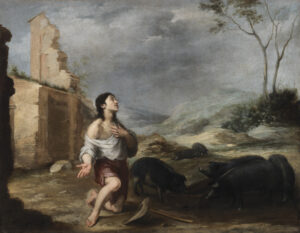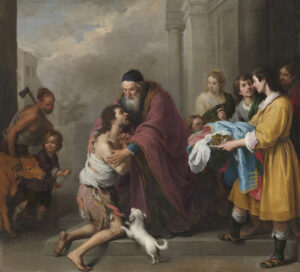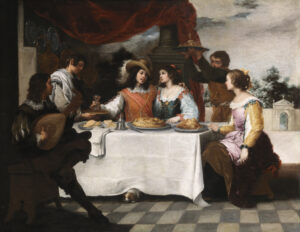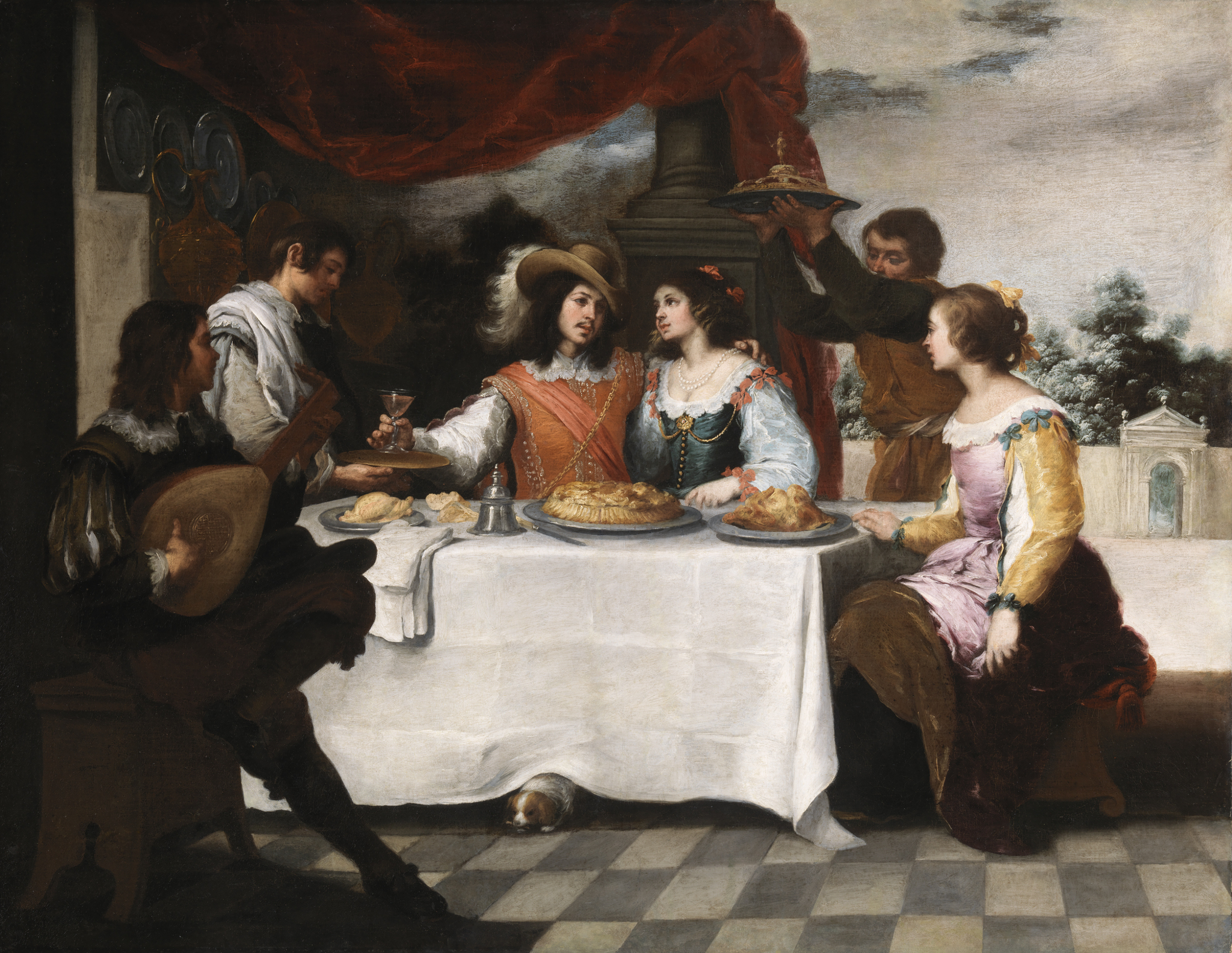A special artistic treat awaits visitors to the Meadows Museum in Dallas. On loan from Dublin is the only complete cycle of paintings by Murillo (1617-1682) that has not been scattered across the globe.
For those who visited the Meadows five years ago, this Murillo cycle depicting the Parable of the Prodigal Son follows nicely with the earlier exhibit of a painting cycle by Zurburan, who influenced Murillo’s early works. That 2017 exhibit, showing Jacob and his Twelve Sons, was another loan from Europe, in that case Auckland Castle in England.
Storytelling through painting was always popular, but in 17th century Spain it was especially expressed in a series, or cycle, of several paintings. At the Meadows the entire parable is printed on one wall, enabling one to understand what is being portrayed. One can then look around a relatively small room that essentially cocoons the viewer in the Prodigal Son cycle. One wall has 2, the third is on a half wall at one end, and the other three complete the wrap-around. On the other side of the half wall is another room devoted exclusively to Murillo. As a special bonus, a third room contains two more Prodigal Son paintings by him, done at a larger scale than the cycle canvases. Overall, the presentation is a perfect showcase for these rare and expressive works.
Of the two additional works, one is entitled The Prodigal Son among the Swine. It is the only one to be vertically oriented. The son dominates the canvas, and we can only glimpse the swine in the distance. His hands are together with fingertips touching, his gaze is heavenward, and he adopts a kneeling posture. The painting reflects his repentance, showing him at his lowest point.
The Return of the Prodigal Son, the other extra painting, is also a much larger canvas than Murillo used for his cycle. It depicts the same scene as the last of his six cycle subjects, with his father embracing him on his return. At left we see the calf that is being brought in for the feast, the very one that so incensed the father’s older son who complained about never being given such an honour despite years of toil. In the last of the cycle paintings, the calf is on the right.
For me, the parable has not one but two prime lessons: the forgiveness of the father for the prodigal son, and the reconciliation he tries to effect with his older son. This is the concluding portion of the parable, but one that does not appear in any painting on display; nor does it appear in a series of engravings on loan from the Metropolitan Museum of Art. These are by the French graphic artist Jacques Callot (1592-1635), and date from the last year of his life. Why artists chose to ignore this important aspect is unclear.
I attended an in-depth look at the costumes worn by the figures in the cycle, hosted by art historian Dr. Rebecca Teresi. “Using fashion to tell a story tells you immediately who everybody is,” she explained. “Some might appear rich or poor, or more prone to virtue or vice. The clothing cues us in without any exposition. In this cycle, seeing how the costume evolves and changes helps advance the narrative. Third, and most importantly, the goal for Murillo is not only to tell the story but also to make it relevant for his audience. He places his characters in clothes from 17th century Seville instead of being an archeologically accurate reconstruction of Biblical times.”
The father on the cycle appears to wear the same sumptuous garb throughout, including a fur-lined coat and fur-lined cap. In the first painting, both of his sons are dressed nearly identically, with expensive lace collars and gold embroidery on the younger sons’ sash. The main difference is that we barely see the face of the younger son in the first and second paintings. “It almost allows us to concern ourselves more into the story from the beginning,” said Teresi. In the second painting the prodigal son wears a red cloak that must have cost a fortune, and even the spurs on his boots are gold. He is leaving his father, with two wagon loads of treasures and supplies, to have a good time.

The flamboyant clothes the prodigal son wears in the third painting is in stark contrast to the final three paintings, where we see him moving down to wearing torn clothes and sharing the canvas with swine. In the third one we see him dallying with a lady of the night (signified by her low-cut bodice), seated at a banquet table laden with rich foods. Underneath peeks a little dog. While it might appear cute, it is a symbol of something far different. “It signifies the good times are not going to last,” said Teresi. The little dog appears again in the fourth canvas, where the son’s credit has been exhausted. The prodigal son is run out of town with swords and brooms.
He is at his lowest state in the fifth painting. Like the depiction in the larger canvas in the adjoining room, the prodigal son is kneeling and looking towards heaven for solace. In this case, the swine are right beside him, not in the background. His clothing is reduced to wearing shorts and a shirt that falls off one shoulder. And of course his hair, nicely coiffed in the third painting, is a matted mess. The final canvas shows him being received back home by his father, behind whom is his older son and two servants.
The exhibit catalogue notes that the inclusion of the older brother here is unusual compared with treatments of the parable by other artists, although Rembrandt also gave pride of place to the older brother in his 1668 painting of the same scene. Unfortunately, that painting is in Russia, so few outsiders will see it again for a long time.
In the catalogue, we learn Murillo’s inclusion of the older brother (at far right) “hints at a specific goal for this series to focus on the sacrament of penance and achievement of grace. It shows Murillo’s ability to adapt his compositions to accommodate specific theological aims.”

Teresi concluded her survey by saying “The redemption tale of an extravagant, unvirtuous, wealthy young man, wasting away his riches before seeing the error of his ways and being welcomed back into the fold, may have resonated with the patron who commissioned the paintings. On a larger scale it may relate to the city of Seville itself, which had fallen on hard times after a decade of extraordinary prosperity.”
A truly fascinating exhibit, and a rare chance to see these works of art in America for the first time. Combined with the large collection of old Spanish works that fills its permanent galleries, this is the ideal time to visit the Meadows if you have not seen it before. And just a short walk away in the George Bush Presidential Library, also on the campus of Southern Methodist University.
For those who want to delve more deeply, there is a very fine 159-page catalogue available in the gift shop of the Meadows Museum.
There is also a 1-hour lecture on how the paintings made their way from Ireland. It is at this link:

Tickets at: www.meadowsmuseumdallas.org
Painting credits:
The 6-painting cycle: National Gallery of Ireland
The Prodigal Son among the Swine: Hispanic Society of America, by exchange, 1997.
The Return of the Prodigal Son: National Gallery of Art, Wash. DC
